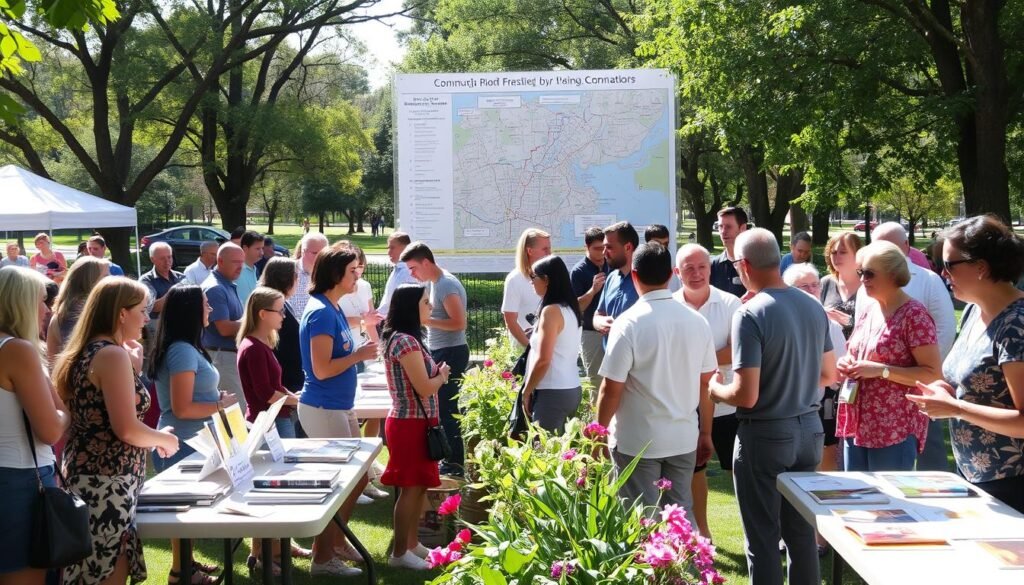Master Constituent Outreach: Essential Tips and Strategies
Over 60 countries have been helped by the National Democratic Institute (NDI) in the last 20 years. They learned how to connect better with their people. This shows how key it is to reach out to your community well.
The guide talks about the importance of being involved, heard, and seen. It also mentions being accountable and open. These are key for good community outreach.
People who elected a legislator are called constituents. They expect to hear from and get help from their elected officials. This shows a direct link between citizens and their leaders.
There are many ways to connect with your community. You can hold public forums, send out newsletters, or help them with local issues. These actions are key for good outreach.
Knowing what your community needs is important. Then, you can make plans to meet those needs. This way, you can gain their trust, which is vital for good outreach.
Key Takeaways
- Developing effective constituent outreach strategies is key for strong community ties.
- Outreach means talking to people, understanding their worries, and helping them.
- Knowing what your community needs is essential for good outreach.
- There are many ways to connect, like forums, newsletters, and helping with local issues.
- Building trust is key for successful outreach. It comes from clear communication and being open.
- Good outreach needs a deep understanding of your community and its needs.
- Outreach strategies should change based on different factors, like how elections work and what resources you have.
Understanding the Foundations of Constituent Outreach
Constituent outreach is key to community engagement. It’s about talking directly to people, hearing their worries, and helping them. Using phone calls, emails, and social media helps a lot in this process.
A report by Sean J. Kealy shows how important it is to talk well with people. It points out the need for clear and open communication. This is vital for building trust and working well together.
Here are some important parts of good constituent engagement:
- Listening well and responding quickly to concerns
- Using clear and timely communication through different ways
- Showing empathy and understanding of what people need
By following these steps, groups can earn trust and create strong bonds with their community. This leads to better community work and outreach.
How to Conduct Effective Constituent Outreach: A Strategic Framework
To do effective outreach, you need a plan. This plan should focus on building relationships with constituents and good stakeholder communication. It’s all about knowing what people need and talking to them in a way that matters.
It’s also important to centralize data and make sure it’s good. This helps you see how well your outreach is working. With the right data, you can make your messages hit home with your audience.
- Creating micro-targeted email campaigns focused on specific demographics
- Utilizing project management tools to plan and execute communication strategies
- Establishing a content calendar to ensure timely and relevant communications
Using these methods and focusing on effective stakeholder communication and building relationships with constituents will help your outreach. This way, you can reach your goals.
| Strategy | Benefits |
|---|---|
| Micro-targeted email campaigns | Increased engagement rates, improved donor retention |
| Project management tools | Enhanced organization, timely execution of communication strategies |
| Content calendar | Relevant and timely communications, improved constituent engagement |
Developing Your Constituent Communication Plan
Creating a good communication plan is key for reaching out effectively. You need to set clear goals, know who you’re talking to, and plan when and how you’ll do it. Using stakeholder engagement techniques helps make a plan that really works for your people.
A good plan should have regular updates, phone calls, and online polls. Keeping in touch often and using different ways to communicate is important. Tailoring messages to specific groups can also boost engagement.
By following these steps and using stakeholder engagement techniques and successful community outreach strategies, you can make a detailed plan. This plan will help you connect with your people and build strong bonds.
Digital Tools and Platforms for Constituent Engagement
It’s key to build strong bonds and trust with people. Using tech is a smart way to do this. A report by Sean J. Kealy shows how important it is for staff and agencies to work together. Digital tools help make this easier.
A good Constituent Relationship Management (CRM) system is vital. It makes work better, handles questions well, and makes people happy. A CRM system should have a few important things:
- Streamlining communication processes
- Improving efficiency in managing inquiries
- Enhancing customer satisfaction through expedient request management
Keeping in touch regularly makes people happier and more involved. Videos are great for this, as they share info fast and make a personal touch. Using these methods helps improve outreach and strengthens ties with people, leading to better engaging with constituents effectively and following community engagement best practices.
Building and Maintaining Constituent Relationships
Building strong relationships with constituents is key. This means being open and honest, talking back and forth, and setting clear expectations. By doing this, organizations can strengthen their outreach and create a community feeling among their supporters.
Good outreach strategies focus on talking directly to people, making sure every interaction is personal and meaningful. Using Constituent Relationship Management (CRM) systems helps manage all this information in one place.
CRM systems offer many benefits. They help keep donors engaged and improve how work is done. They also help make decisions based on solid data. This makes outreach efforts more effective and sustainable over time.
Organizations can also use data to understand how people interact with them. This helps improve outreach by knowing what works best. By focusing on clear communication and using CRM systems and data, organizations can build lasting relationships with their supporters.
Multichannel Outreach Strategies
Effective outreach communication methods are key to strong relationships with people. Using many channels like social media, email, and events helps reach and engage with people.
Recent stats show that using many channels is a best practice. For example, cold emails can bring a 4200% return on investment. LinkedIn messages get three times more replies than emails. SMS has a 98% open rate and a 209% higher reply rate than social media or email.
Some benefits of using many channels include:
- Higher engagement rates
- Better conversion rates
- Stronger brand recognition and trust
By using many channels, people can do better outreach and build stronger ties with their community. This leads to more community engagement and a stronger connection with the community.
The secret to great multichannel outreach is knowing the best practices for community engagement. A good strategy uses many channels and tactics. This way, people can reach their goals better.
Data-Driven Constituent Engagement Techniques
It’s key to connect well with people in your community. Sean J. Kealy’s report shows that looking at feedback and tracking engagement is vital. This way, you can strengthen your ties with the people you serve.
Personalization is a big part of this. Making messages personal can really boost how people respond. For example, emails with personal touches can get up to 26% more opens than generic ones. Also, campaigns that speak directly to people can see a 25% jump in donations on average.
Here are some smart ways to use data for better outreach:
- Using data to shape how you talk to people can get more people to show up to events by about 20%. This happens when invites match what people have done before.
- Sharing stories of how donations help can get people more involved. This can raise engagement by up to 15% compared to just saying thanks.
- Showing how data helps you make a difference can make people see the value of what you do. It proves that the effort and cost of collecting data are worth it.
By using these methods, you can do a better job of reaching out and connecting with your community. This leads to stronger relationships and more successful outreach efforts.
Crisis Communication and Constituent Management
Effective crisis communication is key to keeping trust and ensuring safety in emergencies. Constituent outreach strategies are vital. They help spread timely and accurate info to people. Research shows, 80% of local governments face a crisis every five years.
Good crisis communication means talking to the right people. This includes community leaders, emergency teams, and the media. By being open and clear, organizations help people know what’s happening and how to act.
Some important stats show why crisis communication matters:
- 65% of local officials say their area lacks a good crisis plan
- 70% of cities saw more trust and involvement after using clear plans
- 85% of local governments use social media and websites for emergency info
With good crisis plans, organizations can lower panic and keep people safe. They need to be proactive. This means giving regular updates, being clear, and working with important groups.
Leveraging Social Media for Constituent Connection
Effective community engagement best practices include using social media to connect with people. Platforms like Twitter, Facebook, and Instagram help improve outreach and build stronger relationships. This way, individuals can better connect with their constituents.
Statistics show social media’s role in community engagement. For instance, 69% of U.S. adults use Facebook, 40% Instagram, and 22% Twitter. These platforms offer a wide audience for engagement. They are great for sharing info, getting feedback, and building relationships.
To make the most of social media, follow best practices. Create engaging content, reply to comments and messages, and use hashtags. This boosts your online presence, builds trust, and enhances outreach.
- Sharing engaging content like videos, polls, and live streams
- Quickly and professionally responding to comments and messages
- Using hashtags to make posts more visible and attract followers
- Working with others to spread messages and reach more people
By following these practices and using effective methods, you can use social media to strengthen relationships. This improves community engagement efforts.
Organizing Successful Constituent Events and Forums
Effective stakeholder engagement techniques are key to strong relationships with constituents. Research shows nonprofits that engage well can improve their programs and keep their impacts strong. Holding successful events and forums is a great way to do this. They let constituents share their thoughts and feedback.
To really connect with people, you need to talk to a wide range of them. This means using tools like surveys, focus groups, and town hall meetings. These methods help gather ideas, create programs together, and make people feel they’re part of the solution.
Some benefits of these events and forums include:
- More people get involved, with town hall meetings boosting participation by 30%
- Trust and relationships grow stronger, with personalized outreach boosting success by 25%
- Transparency gets a big boost, with updates on projects increasing by 50%
By using stakeholder engagement techniques and successful community outreach strategies, organizations can make their community more welcoming. This leads to more people getting involved, better relationships, and better results.
Overcoming Common Constituent Outreach Challenges
Building trust and fostering a sense of community is key. Yet, several challenges can get in the way. Community engagement best practices can help tackle these issues. One big challenge is communication barriers. This can be solved by using many channels and formats to reach everyone.
Another hurdle is managing limited resources. This can be overcome by focusing on what’s most important and using technology to make communication easier. It’s also vital to handle the varied needs of constituents. This can be done by using data to understand and meet different needs and preferences.
By following community engagement best practices, like regular town halls and social media, constituents feel heard. This builds trust and strengthens community bonds. Effective engagement also lets constituents give valuable feedback. This feedback can help make better decisions and improve outcomes.
Some key strategies for overcoming common constituent outreach challenges include:
- Using multiple channels and formats to reach diverse audiences
- Prioritizing engagement efforts and leveraging technology to streamline communication
- Using data-driven approaches to understand and cater to different needs and preferences
Conclusion: Future-Proofing Your Constituent Outreach Strategy
As the strategic landscape for constituent outreach strategies keeps changing, it’s key to think ahead. Use data to guide your actions and match your communication with what your stakeholders need. This way, you can create a strong outreach plan that lasts.
The NDI publication offers great advice on making a solid constituent relations strategy. It stresses the need for clear, open, and accountable outreach. By following these principles, you can earn trust and strengthen your bond with your constituents. This will make your advocacy work more effective.
As the world of constituent engagement changes, being able to adapt and innovate is key. Keep up with new trends, use technology, and ask for feedback to improve your plans. With a forward-thinking approach and a focus on your constituents’ needs, you can make your outreach efforts last and help your organization thrive in the long run.
FAQ
What is the importance of mastering constituent outreach?
What are the foundations of effective constituent outreach?
What is the strategic framework for conducting effective constituent outreach?
How can you develop an effective constituent communication plan?
How can digital tools and platforms enhance constituent engagement efforts?
What are the key elements of building and maintaining constituent relationships?
What are the benefits of using multichannel outreach strategies?
How can data-driven constituent engagement techniques enhance outreach efforts?
How can organizations address crisis communication and constituent management challenges?
What are the best practices for leveraging social media for constituent connection?
How can organizations organize successful constituent events and forums?
What are the common constituent outreach challenges and how can they be overcome?
How can organizations future-proof their constituent outreach strategy?
Source Links
- untitled
- The Best Community Outreach Strategies To Win Campaigns
- CWM 2004 Print Package
- Rep. Sylvia Garcia’s Guide to Good Constituent Services
- What’s happening with AI in constituent engagement? — POPVOX Foundation
- Congressional Constituent Service Inquiries | The Regulatory Review
- 7 Tips On How To Build An Effective Outreach Strategy
- Building a Data-Driven Constituent Outreach Strategy
- How to Create a Winning Constituent Communications Strategy | Fireside
- How counties are taking control of constituent communication
- 6 Ways to Improve Constituent Engagement | Fireside
- How to Improve Constituent Engagement | Rellevate
- Your nonprofit’s guide to Constituent Relationship Management
- Constituent relationship management: A guide for success
- Constituent relationship management: The ultimate guide to CRM
- Multichannel Outreach: An Ultimate Guide For Sales
- Multichannel donor outreach: A guide for nonprofits
- Step-by-Step Guide to Tailor an Effective Multichannel Cold Outreach Strategy – Scale Up Sales
- Data-Driven Donor Engagement: 4 Foundational Strategies
- The First Steps to Creating Your Data Engagement Strategy
- %%title%% %%page%% %%sep%% Carahsoft Blog
- How to Make a Crisis Communication Plan: Tips for Municipal Emergency Management Planning with GovPilot
- Keeping in Touch with Key Constituents: A Communication Check List during Times of Crisis
- A Guide to Effective Incident Management Communications
- Ways Your City Officials Should Connect With Their Constituents From GovPilot
- How to Build a Winning Social Media Strategy for Advocacy | VoterVoice
- Constituent Engagement
- Strategies for Effective Communication with Constituents
- Serving As a Representative of the People: A Guide to Engaging Your Constituents
- How to Create an Effective Public Engagement Strategy for Your Organization | ThoughtExchange
- Microsoft Word – 24-6-4_Final Rpt_Cong. Constituent Svc. Inquiries
- How to Future-Proof Your Workforce Skills Strategy in 5 Steps
























